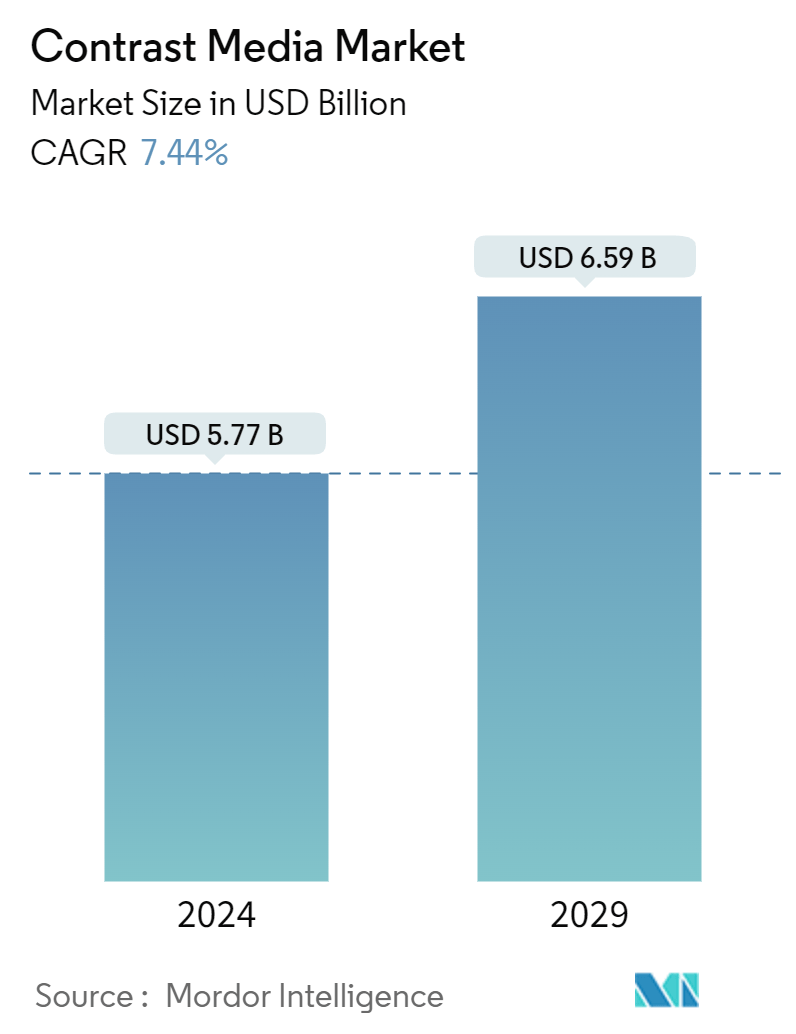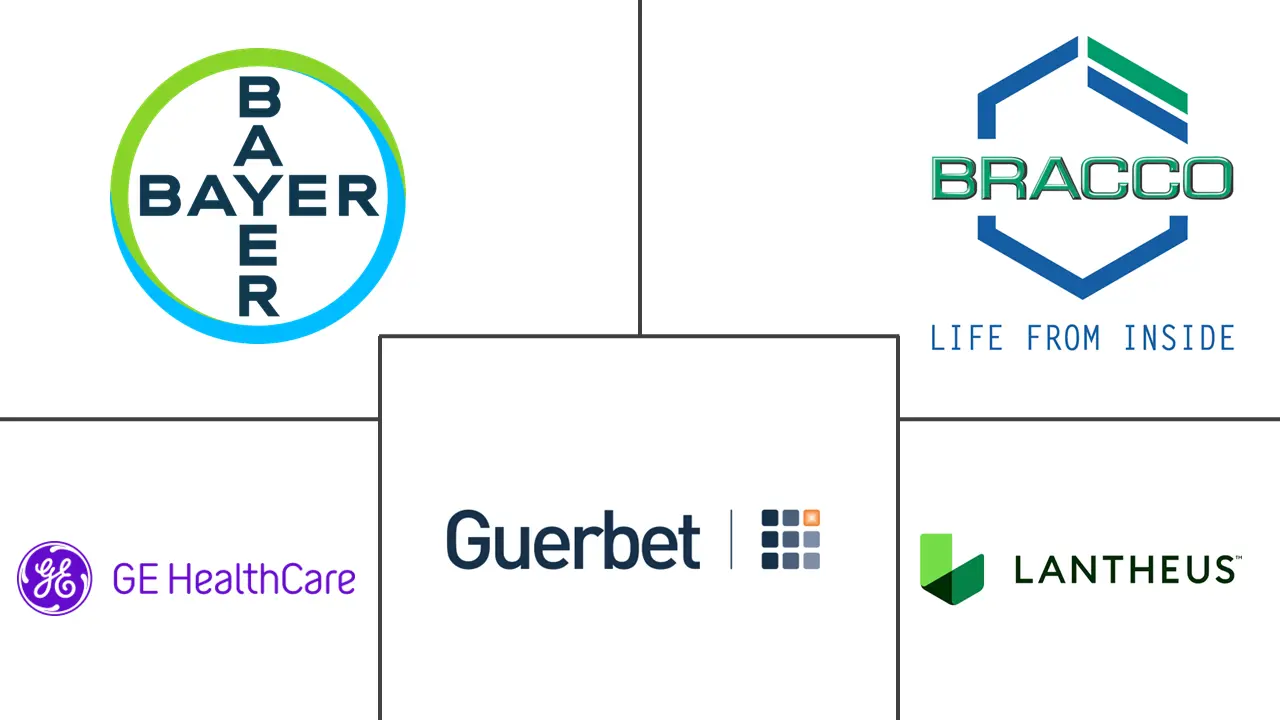Market Size of Contrast Media Industry

| Study Period | 2019 - 2029 |
| Market Size (2024) | USD 5.77 Billion |
| Market Size (2029) | USD 6.59 Billion |
| CAGR (2024 - 2029) | 7.44 % |
| Fastest Growing Market | Asia-Pacific |
| Largest Market | North America |
Major Players
*Disclaimer: Major Players sorted in no particular order |
Need a report that reflects how COVID-19 has impacted this market and its growth?
Contrast Media Market Analysis
The Contrast Media Market size is estimated at USD 5.77 billion in 2024, and is expected to reach USD 6.59 billion by 2029, growing at a CAGR of 7.44% during the forecast period (2024-2029).
Contrast media (CM) are used in imaging techniques to enhance the differences between body tissues in images. The ideal contrast medium should achieve a very high tissue concentration without adverse effects. The factors for the growth of the contrast media market include the increasing incidences of chronic diseases and the rising demand for image-guided procedures and diagnostics. For instance, according to the British Heart Foundation Report 2024, around 7.6 million people with heart and circulatory diseases live in the United Kingdom. Hence, the high prevalence of circulatory diseases is expected to increase the diagnosis rate, ultimately driving the studied market.
Additionally, as per the 2022 update from the International Diabetic Federation (IDF), approximately 537 million adults aged 20-79 had diabetes in 2022. The total number of people with diabetes is projected to rise to 783 million by 2045. Hence, the high prevalence of diabetes is expected to drive the studied market over the forecast period.
Similarly, according to the update from the National Cancer Institute, in March 2023, around 0.3 million new breast cancer cases were registered in the United States, and the new cases of colon and rectal cancer were 0.1 million and 46 thousand, respectively. The high prevalence of chronic diseases such as cancer, which led to an increasing need for diagnostic procedures and treatment, is expected to drive the growth of the contrast media market. The rising demand for image-guided procedures and diagnostics is also leading to market growth. For instance, according to an article published in Nanomaterials in July 2023, scientists put forward many research ideas to enhance the precision of observing diseased body parts by understanding the synergistic potential of MRI in combination with contrast agents (CAs). Hence, the broad application of contrast agents in image-guided procedures is expected to drive the demand for CAs, ultimately driving the studied market over the forecast period. Hence, factors such as the increasing prevalence of chronic diseases and rising demand for image-guided procedures that use contrast agents are expected to drive the studied market over the forecast period. However, side effects and allergic reactions associated with contrast agents are expected to restrain the market.
Contrast Media Industry Segmentation
As per the scope of the report, contrast media is a substance used to enhance the contrast of an image and, thus, make the image more detailed and precise. Contrast media is increasingly used in various medical imaging techniques, such as MRI and CT. The contrast media market is segmented by type, procedure, indication, and geography. By type, the market is segmented into iodinated contrast media, gadolinium-based contrast media, microbubble contrast media, and barium-based contrast media. By procedure, the market is segmented into X-ray/computed tomography (CT), magnetic resonance imaging (MRI), and ultrasound. By indication, the market is segmented into cardiovascular disease, oncology, gastrointestinal disorders, neurological disorders, and other indications. By geography, the market is segmented into North America, Europe, Asia-Pacific, Middle East and Africa, and South America. The report also covers the estimated market sizes and trends of 17 countries across major regions globally. The report offers values (in USD) for the above segments.
| By Type | |
| Iodinated Contrast Media | |
| Gadolinium-based Contrast Media | |
| Microbubble Contrast Media | |
| Barium-based Contrast Media |
| By Procedure | |
| X-ray/Computed Tomography (CT) | |
| Magnetic Resonance Imaging (MRI) | |
| Ultrasound |
| By Indication | |
| Cardiovascular Disease | |
| Oncology | |
| Gastrointestinal Disorders | |
| Neurological Disorders | |
| Other Indications |
| By Geography | ||||||||
| ||||||||
| ||||||||
| ||||||||
| ||||||||
|
Contrast Media Market Size Summary
The contrast media market is poised for significant growth, driven by the increasing prevalence of chronic diseases and the rising demand for image-guided procedures. Contrast media, essential in enhancing the visibility of tissues during imaging, are becoming increasingly vital due to the growing incidence of conditions such as heart disease, diabetes, and cancer. The market is expected to expand as these diseases necessitate more diagnostic procedures, thereby boosting the demand for contrast agents. The broad application of these agents in various imaging techniques, coupled with advancements in their formulation, is further propelling market growth. However, the market faces challenges from potential side effects and allergic reactions associated with contrast agents, which could restrain its expansion.
The iodinated contrast media segment is anticipated to experience robust growth, supported by its clinical advancements and the rising number of cancer cases globally. The non-ionic and low osmolality properties of iodinated contrast media enhance their safety and efficacy, making them a preferred choice in diagnostic procedures. Strategic alliances and product approvals, particularly in North America, are expected to bolster market growth. The region's increasing disease burden and investment in healthcare are key factors contributing to the market's expansion. The market is characterized by a few dominant players who are actively engaging in new product developments and partnerships to maintain their competitive edge.
Contrast Media Market Size - Table of Contents
-
1. MARKET DYNAMICS
-
1.1 Market Overview
-
1.2 Market Drivers
-
1.2.1 Increase in the Incidences of Chronic Diseases
-
1.2.2 Rising Demand for Image-guided Procedures and Diagnostics
-
1.2.3 Large Number of Approvals for Contrast Agents
-
-
1.3 Market Restraints
-
1.3.1 Side Effects and Allergic Reactions Associated with Contrast Agents
-
-
1.4 Industry Attractiveness - Porter's Five Forces Analysis
-
1.4.1 Threat of New Entrants
-
1.4.2 Bargaining Power of Buyers/Consumers
-
1.4.3 Bargaining Power of Suppliers
-
1.4.4 Threat of Substitute Products
-
1.4.5 Intensity of Competitive Rivalry
-
-
-
2. MARKET SEGMENTATION (Market Size by Value – USD)
-
2.1 By Type
-
2.1.1 Iodinated Contrast Media
-
2.1.2 Gadolinium-based Contrast Media
-
2.1.3 Microbubble Contrast Media
-
2.1.4 Barium-based Contrast Media
-
-
2.2 By Procedure
-
2.2.1 X-ray/Computed Tomography (CT)
-
2.2.2 Magnetic Resonance Imaging (MRI)
-
2.2.3 Ultrasound
-
-
2.3 By Indication
-
2.3.1 Cardiovascular Disease
-
2.3.2 Oncology
-
2.3.3 Gastrointestinal Disorders
-
2.3.4 Neurological Disorders
-
2.3.5 Other Indications
-
-
2.4 By Geography
-
2.4.1 North America
-
2.4.1.1 United States
-
2.4.1.2 Canada
-
2.4.1.3 Mexico
-
2.4.1.4 Rest of North America
-
-
2.4.2 Europe
-
2.4.2.1 Germany
-
2.4.2.2 United Kingdom
-
2.4.2.3 France
-
2.4.2.4 Italy
-
2.4.2.5 Spain
-
2.4.2.6 Rest of Europe
-
-
2.4.3 Asia-Pacific
-
2.4.3.1 China
-
2.4.3.2 Japan
-
2.4.3.3 India
-
2.4.3.4 Australia
-
2.4.3.5 South Korea
-
2.4.3.6 Rest of Asia-Pacific
-
-
2.4.4 Middle East and Africa
-
2.4.4.1 GCC
-
2.4.4.2 South Africa
-
2.4.4.3 Rest of Middle East and Africa
-
-
2.4.5 South America
-
2.4.5.1 Brazil
-
2.4.5.2 Argentina
-
2.4.5.3 Rest of South America
-
-
-
Contrast Media Market Size FAQs
How big is the Contrast Media Market?
The Contrast Media Market size is expected to reach USD 5.77 billion in 2024 and grow at a CAGR of 7.44% to reach USD 6.59 billion by 2029.
What is the current Contrast Media Market size?
In 2024, the Contrast Media Market size is expected to reach USD 5.77 billion.

